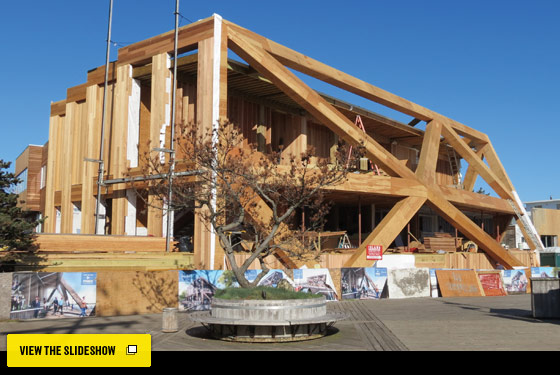
This Memorial Day, Fire Island Pines, the tidily uniform gay beach hamlet off Long Island, gets its sweaty, drunken heart back. That’s when the Pavilion, the dance club at the town’s center that burned down in the fall of 2011, reopens, designed by the young architects at HWKN to reflect the old Pines (cedar-walled, flat-roofed modernism) and accommodate the new (it can also function as a wedding chapel, and there’s an art gallery).
It might seem strange to think today, but when it was developed in the fifties, the Pines wasn’t meant to be gay—just another weekend getaway. But because it was next door to Cherry Grove, the community of theatrical bungalows filled with theatrical men, the Pines began to attract closeted gays, who by the mid-sixties defined the place. In those days, the Pines was seen as an “untainted address,” observes Christopher Rawlins in Fire Island Modernist, his new book about Horace Gifford, who designed just about one in ten houses there. Gifford was a strapping idealist, and his houses were communal, economical, and exhibitionistic: the bedrooms small, the central areas open, with everything wooden or glass (he “essentially treated all surfaces like floors,” Rawlins writes). Gifford’s was a gay architectural vernacular that eschewed camp—“butch,” Rawlins calls it. “But in its muscular austerity,” he writes, “a hypermasculine form of drag could also be discerned.” As time went on, the houses became more elaborate, with conversation pits and make-out lofts—a form of sexed-up cocaine modernism. Gifford, a fixture in the community, embodied this pre-AIDS boundarylessness.
Unlike the old Pavilion, which presented a blank wall on the harbor, the new one has been erected in Gifford’s style, skylit and open. “It’s so beautiful when the architecture disappears,” explains HWKN’s Matthias Hollwich. “It’s all about the people.”

The new Pavilion, still under construction. Photo: Courtesy of FIP Ventures LLC

Photo: Tom Yee/Courtesy of Artbook D.A.P.

Photo: Tom Yee/Courtesy of Artbook D.A.P.

Photo: Horace Gifford/Courtesy of Ed DiGuardia and Artbook D.A.P.
